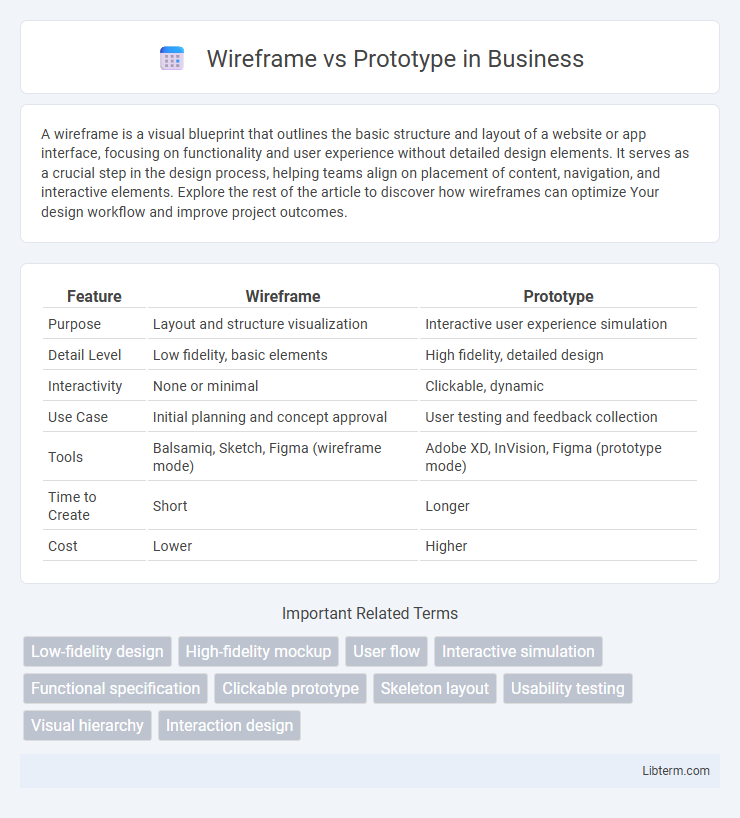A wireframe is a visual blueprint that outlines the basic structure and layout of a website or app interface, focusing on functionality and user experience without detailed design elements. It serves as a crucial step in the design process, helping teams align on placement of content, navigation, and interactive elements. Explore the rest of the article to discover how wireframes can optimize Your design workflow and improve project outcomes.
Table of Comparison
| Feature | Wireframe | Prototype |
|---|---|---|
| Purpose | Layout and structure visualization | Interactive user experience simulation |
| Detail Level | Low fidelity, basic elements | High fidelity, detailed design |
| Interactivity | None or minimal | Clickable, dynamic |
| Use Case | Initial planning and concept approval | User testing and feedback collection |
| Tools | Balsamiq, Sketch, Figma (wireframe mode) | Adobe XD, InVision, Figma (prototype mode) |
| Time to Create | Short | Longer |
| Cost | Lower | Higher |
Introduction to Wireframes and Prototypes
Wireframes serve as low-fidelity visual guides that outline the basic structure and layout of a digital interface, concentrating on content placement and user flow without detailed design elements. Prototypes, by contrast, are interactive simulations that replicate the user experience and functionality of the final product, enabling usability testing and validation before development. Both wireframes and prototypes play essential roles in the design process by progressively refining concepts from static blueprints to dynamic models.
What is a Wireframe?
A wireframe is a low-fidelity visual guide that outlines the basic structure and layout of a digital interface, focusing on content placement and functionality without detailed design elements. It serves as a blueprint for user experience (UX) designers to map out navigation paths, interface elements, and user interactions early in the design process. Wireframes help stakeholders and developers understand the overall framework before moving on to high-fidelity prototypes or final designs.
What is a Prototype?
A prototype is an interactive, high-fidelity representation of a product that simulates user experience and functionality to test design concepts and usability. Unlike wireframes, prototypes incorporate detailed visuals and clickable elements, allowing stakeholders and users to interact with the design flow. Prototyping tools such as Figma, Adobe XD, and InVision enable developers to validate ideas, identify issues early, and refine the user interface before final development.
Key Differences Between Wireframes and Prototypes
Wireframes are low-fidelity visual guides that outline the structure and layout of a webpage or app, focusing on content placement without interactive elements. Prototypes are high-fidelity, interactive simulations that demonstrate design functionality, allowing users to experience navigation and user interface behavior. Key differences include fidelity level, interactivity, purpose in the design process, and user feedback applicability.
When to Use Wireframes in the Design Process
Wireframes are essential in the early stages of the design process to establish the basic structure and layout without distractions from color or detailed graphics. They help designers and stakeholders focus on content placement, user flow, and functionality, ensuring alignment before investing time in high-fidelity visuals. Using wireframes facilitates quick iterations and feedback, saving resources by identifying usability issues early.
When to Use Prototypes in the Design Process
Prototypes are essential during the later stages of the design process when interactive elements and user experience need to be tested and validated. They allow designers to simulate functionality, gather user feedback on usability, and identify potential issues before development begins. Using prototypes helps reduce costly changes post-launch and enhances communication among stakeholders by providing a tangible representation of the final product.
Advantages of Wireframing
Wireframing offers a clear visual guide that outlines the basic structure and layout of a website or app, enabling efficient communication between designers, developers, and stakeholders. It allows for rapid iteration and early detection of usability issues without the distraction of detailed visuals or interactive elements, saving time and resources in the design process. Wireframes also help establish a strong foundation for user experience by focusing on content placement and navigation flow before moving into more complex prototyping stages.
Benefits of Prototyping
Prototyping enables early visualization of design concepts, facilitating user feedback and iterative improvements that significantly enhance usability and functionality. It reduces development risks by identifying potential issues before coding, saving time and resources. Prototypes also improve communication among stakeholders by providing a tangible representation of the final product, ensuring alignment and clearer project expectations.
Choosing the Right Tool: Wireframe or Prototype?
Selecting between a wireframe and a prototype depends on the project stage and goals; wireframes serve as low-fidelity blueprints ideal for outlining basic layouts and functionality, while prototypes offer high-fidelity, interactive simulations to test user experience and design flow. Wireframes prioritize structural clarity with simplified visuals, making them perfect for early-stage feedback and rapid iteration, whereas prototypes provide detailed interactivity and aesthetics, essential for usability testing and stakeholder presentations. Choosing the right tool enhances development efficiency by aligning deliverables with user needs, design complexity, and project timelines.
Conclusion: Combining Wireframes and Prototypes for Effective UX Design
Combining wireframes and prototypes enhances UX design by leveraging wireframes' simplicity to map structure and prototypes' interactivity to test functionality. This approach allows designers to identify usability issues early and iterate efficiently, resulting in a user-centered, well-refined product. Integrating both tools streamlines communication between stakeholders and development teams, optimizing the overall design process.
Wireframe Infographic

 libterm.com
libterm.com